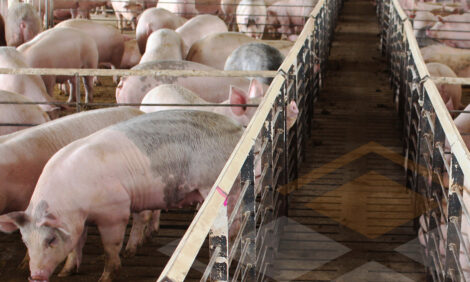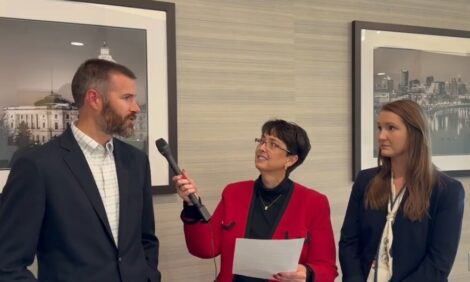



The National Committee for Pig Production, Annual report 2003
By Danish Bacon & Meat Council, Danish Agriculture, and the Danish Pig Producers’ Association - The National Committee for Pig Production safeguards strategy, development and information tasks concerning the live pig, and has an ordinary net budget for the year 2003/2004 of DKK93.85 million. This report reviews a broad range of issues important to the pig producer.
 In 2003, the recession really fastened on
with negative figures in the accounts and
liquidity problems for many pig producers.
Furthermore, the Danish price was not
competitive compared with that of other
countries such as Germany.
In 2003, the recession really fastened on
with negative figures in the accounts and
liquidity problems for many pig producers.
Furthermore, the Danish price was not
competitive compared with that of other
countries such as Germany.
Structural development
However, many Danish pig producers are
still rather confident about the future,
and many renovate and expand their production.
These activities also indicate that
the structural development continues with
undiminished force, and currently, typically
very large sow units with sale of weaners
for e.g. WTF production are
established.
As opposed to many other countries, we
have not seen a decrease in the production.
The pigs change addresses, and overall
the Danish pig production is very stable.
The export is increasing. It is therefore
crucial that the coming EU transport regulations
do not become so extensive that
they completely block the indispensable
valve that the export to Germany is.
Environmental regulation
The structural development is increasingly
controlled by the environmental regulation
and the struggle for land, and the pig
industry has still not been given a scientific
reason for the regulation of max. 140
kg N per hectare from pig slurry.
The National Committee for Pig Production
works scientifically and positively for a
reduction and for a long term balance in
the emission of phosphorus. However, a
tough regulation in connection with the
Action Plan for the Aquatic Environment III
will hardly change anything in relation to
the aquatic environment, as the field leaching
is relatively modest.
In terms of a reduction of odour and
ammonia, the many trials carried out by
the National Committee in co-operation
with the Danish Institute of Agricultural
Sciences and a number of creative companies
and inventors prepare the ground for
optimism. The technical possibilities are
well under way, but much still needs to be
clarified. This also applies to the economics
and the operational safety, and to how
the authorities choose to handle the new
options.
Image and animal welfare
No other pig producers can match the
Danish ones in terms of the high standards
of animal welfare, the low consumption of
medication and the efforts in the environmental
area. Yet massive press coverage
continuously accuses the pig industry of
being unscrupulous.
Unfortunately, there are still many herds
that do not deal with shoulder sores, tail
biting and overcrowding. In the coming
months, the National Committee for Pig
Production will put extra focus on animal
welfare so that pig producers, vets and pig
advisors can straighten things out in cooperation.
All pig producers must be able
to open up their housing units and receive
visitors with or without a TV camera.
Compared with other countries, the
Danish pigs are housed in production
systems that highly benefit animal welfare.
And the many new pens and housing
units that are being built these years create
a decisive head start.
The interpretation of the legislation concerning
enrichment/rooting materials for
all weaners and finishers is clear, and the
National Committee for Pig Production
works intensively on providing the necessary
scientific solutions that are also practically
applicable.
Health and breeding
In its breeding work, National Committee’s
effort within fertility has been an unconditional
success. The next step will be selecting
for better maternal traits to ensure
weaning of large and healthy pigs. The
mortality in the weaner unit must be
reduced and it will be interesting to see
the influence of the new gene technological
possibilities. The first step has now
been taken in terms of selecting for coli
diarrhoea.
The consumption of prescription antibiotics
is now stabilised after the antibiotic
growth promoters were removed from the
feed. PMWS is spreading across most of
the country. The National Committee has
given top priority to PMWS and we work
hard on finding the cause and on coming
up with efficient methods of treatment.
Nutrition and reproduction
The scientific work of the National Committee contains many interesting projects concerning nutrition and reproduction. Activities that help keeping the costs down and ensure an efficient production. Large sow units with group-housed sows and batch production requires a lot from the management and a stable, high farrowing rate. In the finisher production, one must keep an open eye on the feed conversion that is among others ensured through the new and more need-oriented feed evaluation system. As with Salmonella, progress in terms of nutrition has been made for Lawsonia. The feed is still the key to a good gastro-intestinal health.
Thank you
Despite the economic crisis there is no
doubt that the Danish pig industry stands
relatively strong. A unique co-operation
has been established concerning the scientific
development tasks. Pig producers,
advisors, companies and governmental
research institutions all contribute to the
ongoing development and transition process
that is the key to success.
Thank you for the co-operation.
Yours Sincerely,
The National Committee for Pig Production
Lindhart Nielsen / Orla Grøn Pedersen
Contents of the annual report 2003
Statistics
- Budget and Strategy
- Sale of breeding stock
- Productivity
- Economy
- Genetic progress
- Production level
- Research and development
- Artificial insemination
- Longevity of sows
- Feeding of gestating sows
- Sow milk
- Dosing and segregation of feed
- Feeding of weaners and finishers
- Lean meat percentage
- Liquid feeding – a check-list
- The new feed units
- Phosphorus in feed and slurry
- Slurry treatment and economy
- Ammonia and odour
- Odour and feed
- Climate and immediate environment
- Housing of sows
- Housing of weaners and finishers
- Ventilation and energy
- Legislation on animal welfare
- Enrichment
- Ecology and outdoor production
- The production report – economic follow-up
- Planning and surveillance of the production
- Time consumption
- Human Resources management
- Pneumonia
- Reasons for culling of sows
- Leg problems and hoof trimming
- Post-weaning diarrhoea
- Lawsonia
- PMWS
- Salmonella
- Streptococcal meningitis
- Published results, 2002-2003
- Subject index
Source: The Danish National Committee for Pig Production - 2003







